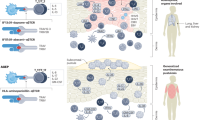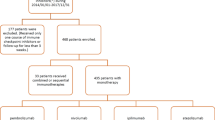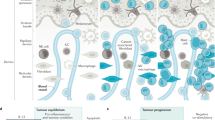Abstract
The protein kinase inhibitor imatinib has been approved as an efficient anticancer drug with common but mild cutaneous toxicities. We here report on two out of four melanoma patients treated with high-dose imatinib presenting with severe and strongly dose-dependent skin eruptions, suggesting a cutaneous reactivity pattern different from allergic hypersensitivity.
Similar content being viewed by others
Main
Imatinib mesylate (Gleevec, formerly STI571, Novartis, Basel, Switzerland) is a selective inhibitor of the tyrosine kinase family including the oncogenes Abl and Kit as well as the platelet-derived growth factor receptor (PDGF-R). Owing to its mechanisms of action, imatinib has been used successfully in chronic myelogenous leukaemia (CML) and in gastrointestinal stromal tumours (GIST). Dose-escalation studies proved imatinib as a well-tolerated oral drug with rare dose-limiting toxicities (Druker et al, 2001). Nevertheless, severe cutaneous side effects have been reported, leading to a cessation of imatinib treatment in single cases (Brouard and Saurat, 2001).
We here report on the first four patients being enrolled into a clinical phase II study investigating imatinib as a second-line therapy in advanced melanoma. The study's rationale was based on the well-known expression of c-kit as well as PDGF-R in melanoma cell lines and tissues (Ohashi et al, 1996). Albeit the patients' clinical outcome still has to be awaited, we hereby provide a first report of the noticeable strong and frequent cutaneous adverse events.
Description of cases
All four patients received imatinib 400 mg b.i.d. (800 mg day−1) after progression of melanoma disease under a first-line cytostatic regimen was ascertained. Patients' clinical data are summarized in Table 1(A). Three of four patients showed moderate to strong cutaneous reactions with a macular and/or urticarial pattern within the first two weeks of therapy (Figure 1A, B). The exanthema emanated from the face and trunk, and subsequently afflicted the extremities. Other side effects were of mild to moderate intensity including fluid retention, nausea, vomiting and fatigue. As a result of the severity of skin reactions, 50% dose adjustments became necessary in two of three patients. Additionally, corticosteroids (methylprednisolon 60 mg day−1 p.o.) were given in one patient. The cutaneous eruptions regressed in all three patients within 2–3 weeks. Thereafter, imatinib was again escalated to 75% of the initial dose (600 mg day−1) in patients 2 and 3, leading to a strong relapse of skin eruptions in both cases. During the further course of treatment, imatinib was left at 50% reduction (400 mg day−1) in these two patients, resulting in no further skin reactions.
Photographs and photomicrographs of patient 3 at day 10 after the onset of treatment with imatinib 800 mg day−1. (A, B) Face and trunk of the patient showing generalised macular and urticarial cutaneous eruptions. (C) Haematoxylin–eosin staining of lesional skin revealing a mononuclear infiltrate and marked oedema of the upper dermis; magnification 1 : 200. (D, E) Immunohistochemical staining of lesional skin showing strong expression of c-kit (CD117) in discrete mononuclear cells (arrows) of the upper dermis; magnification 1 : 100 (D) and 1 : 400 (E). (F) Giemsa staining revealing an increased number of mast cells (arrows) in the upper dermis of lesional skin; magnification 1 : 400.
Histological analyses and discussion
A review of the literature revealed mild to moderate cutaneous reactions as a common side effect to imatinib (Table 1(B)). In contrast, severe skin reactions are rarely reported but, however, occurred following high treatment doses of 600–1000 mg day−1 as used in a phase I trial in GIST (van Oosterom et al, 2001) as well as in our ongoing study. Histological analyses of biopsy specimens of lesional skin from patients 2 and 3 revealed loose mononuclear cells infiltrating the dermis with a perivascular pattern (Figure 1C). The upper dermis showed marked oedema and, remarkably, an increased number of mast cells. Immunohistochemical analyses using polyclonal goat-anti-human antibodies A4502 (DAKO, Hamburg, Germany) recognising the c-kit gene product CD117 revealed a strong staining of mononuclear cells of the dermis morphologically corresponding to mast cells (Figure 1D, E), as additionally confirmed by Giemsa staining (Figure 1F). Human mast cells, which express a functional c-kit receptor, are known to be susceptible to tyrosine kinase inhibition by imatinib leading to impaired proliferation as well as induction of apoptosis (Ma et al, 2002). Therefore, an enhanced proliferation of mast cells as observed in our patients seems to be unlikely mediated via c-kit inhibition on the mast cells themselves. We therefore suggest imatinib to act as a dose-dependent inducer of chemoattractant substances like, for example, cytokines and growth factors leading to dermal mast cell accumulation. Nevertheless, the precise mechanism of action needs to be further elucidated.
We conclude that imatinib acts as a dose-dependent inducer of cutaneous adverse reactions with mainly mild reactivity to low or intermediate doses (200–600 mg day−1) but severe eruptions to high doses (600–1000 mg day−1) of the drug. Our findings should stimulate further investigation of the cutaneous reaction profile to imatinib. To avoid strong cutaneous adverse reactions, however, treatment with low or intermediate doses of imatinib should be preferred in comparison with high doses of this drug whenever feasible.
Change history
16 November 2011
This paper was modified 12 months after initial publication to switch to Creative Commons licence terms, as noted at publication
References
Brouard M, Saurat JH (2001) Cutaneous reactions to STI571. N Engl J Med 345: 618–619
Demetri GD, von Mehren M, Blanke CD, van den Abbeele AD, Eisenberg B, Roberts PJ, Heinrich MC, Tuveson DA, Singer S, Janicek M, Fletcher JA, Silverman SG, Silberman SL, Capdeville R, Kiese B, Peng B, Dimitrijevic S, Druker BJ, Corless C, Fletcher CD, Joensuu H (2002) Efficacy and safety of imatinib mesylate in advanced gastrointestinal stromal tumors. N Engl J Med 347: 472–480
Druker BJ, Talpaz M, Resta DJ, Peng B, Buchdunger E, Ford JM, Lydon NB, Kantarjian H, Capdeville R, Ohno-Jones S, Sawyers CL (2001) Efficacy and safety of a specific inhibitor of the BCR–ABL tyrosine kinase in chronic myeloid leukemia. N Engl J Med 344: 1031–1037
Kantarjian H, Sawyers C, Hochhaus A, Guilhot F, Schiffer C, Gambacorti-Passerini C, Niederwieser D, Resta D, Capdeville R, Zoellner U, Talpaz M, Druker B, Goldman J, O'Brien SG, Russell N, Fischer T, Ottmann O, Cony-Makhoul P, Facon T, Stone R, Miller C, Tallman M, Brown R, Schuster M, Loughran T, Gratwohl A, Mandelli F, Saglio G, Lazzarino M, Russo D, Baccarani M, Morra E (2002) Hematologic and cytogenetic responses to imatinib mesylate in chronic myelogenous leukemia. N Engl J Med 346: 645–652
Ma Y, Zeng S, Metcalfe DD, Akin C, Dimitrijevic S, Butterfield JH, McMahon G, Longley BJ (2002) The c-KIT mutation causing human mastocytosis is resistant to STI571 and other KIT kinase inhibitors; kinases with enzymatic site mutations show different inhibitor sensitivity profiles than wild-type kinases and those with regulatory-type mutations. Blood 99: 1741–1744
Ohashi A, Funasaka Y, Ueda M, Ichihashi M (1996) c-KIT receptor expression in cutaneous malignant melanoma and benign melanotic naevi. Melanoma Res 6: 25–30
Sawyers CL, Hochhaus A, Feldman E, Goldman JM, Miller CB, Ottmann OG, Schiffer CA, Talpaz M, Guilhot F, Deininger MW, Fischer T, O'Brien SG, Stone RM, Gambacorti-Passerini CB, Russell NH, Reiffers JJ, Shea TC, Chapuis B, Coutre S, Tura S, Morra E, Larson RA, Saven A, Peschel C, Gratwohl A, Mandelli F, Ben-Am M, Gathmann I, Capdeville R, Paquette RL, Druker BJ (2002) Imatinib induces hematologic and cytogenetic responses in patients with chronic myelogenous leukemia in myeloid blast crisis: results of a phase II study. Blood 99: 3530–3539
Talpaz M, Silver RT, Druker BJ, Goldman JM, Gambacorti-Passerini C, Guilhot F, Schiffer CA, Fischer T, Deininger MW, Lennard AL, Hochhaus A, Ottmann OG, Gratwohl A, Baccarani M, Stone R, Tura S, Mahon FX, Fernandes-Reese S, Gathmann I, Capdeville R, Kantarjian HM, Sawyers CL (2002) Imatinib induces durable hematologic and cytogenetic responses in patients with accelerated phase chronic myeloid leukemia: results of a phase 2 study. Blood 99: 1928–1937
van Oosterom AT, Judson I, Verweij J, Stroobants S, Donato di Paola E, Dimitrijevic S, Martens M, Webb A, Sciot R, Van Glabbeke M, Silberman S, Nielsen OS (2001) Safety and efficacy of imatinib (STI571) in metastatic gastrointestinal stromal tumours: a phase I study. Lancet 358: 1421–1423
Author information
Authors and Affiliations
Corresponding author
Rights and permissions
From twelve months after its original publication, this work is licensed under the Creative Commons Attribution-NonCommercial-Share Alike 3.0 Unported License. To view a copy of this license, visit http://creativecommons.org/licenses/by-nc-sa/3.0/
About this article
Cite this article
Ugurel, S., Hildenbrand, R., Dippel, E. et al. Dose-dependent severe cutaneous reactions to imatinib. Br J Cancer 88, 1157–1159 (2003). https://doi.org/10.1038/sj.bjc.6600893
Received:
Accepted:
Published:
Issue Date:
DOI: https://doi.org/10.1038/sj.bjc.6600893
Keywords
This article is cited by
-
Diagnosis and Management of Dermatologic Adverse Events from Systemic Melanoma Therapies
American Journal of Clinical Dermatology (2023)
-
Hautveränderungen durch „targeted therapies“
best practice onkologie (2009)
-
Hautveränderungen durch „targeted therapies“ bei onkologischen Patienten
Der Hautarzt (2009)
-
Haut- und Schleimhauttoxizität neuer Substanzen
Der Onkologe (2009)
-
Kutane Nebenwirkungen molekular zielgerichteter Therapien
Der Hautarzt (2008)




